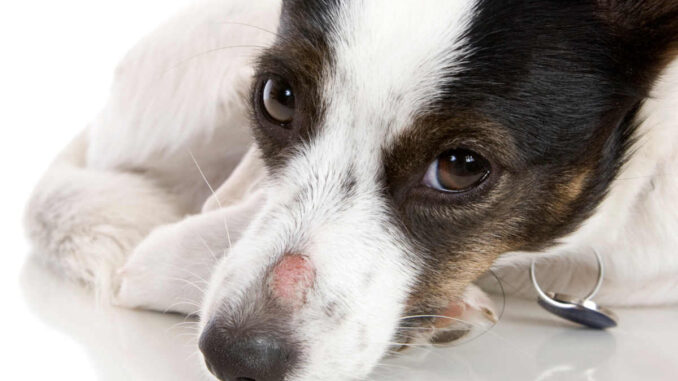
This article was updated on October 19th, 2023

Ringworm is a fungal infection that can cause circular lesions on your dog’s skin. Despite its name, it is not caused by any worm or parasite. It can however spread to humans and other animals, so it’s important to know the signs.
This page features 12 pictures of ringworm in dogs, ranging from mild to severe cases. The images were carefully selected by our board-certified vet dermatologist Dr. Ian Spiegel and our veterinary team.
What exactly is ringworm? (with pictures)
Despite being named after a worm, ringworm is actually caused by a fungus. The infection results in hair loss and scaly patches of skin, as shown on the picture below.
1. Pictures of mild to moderate cases
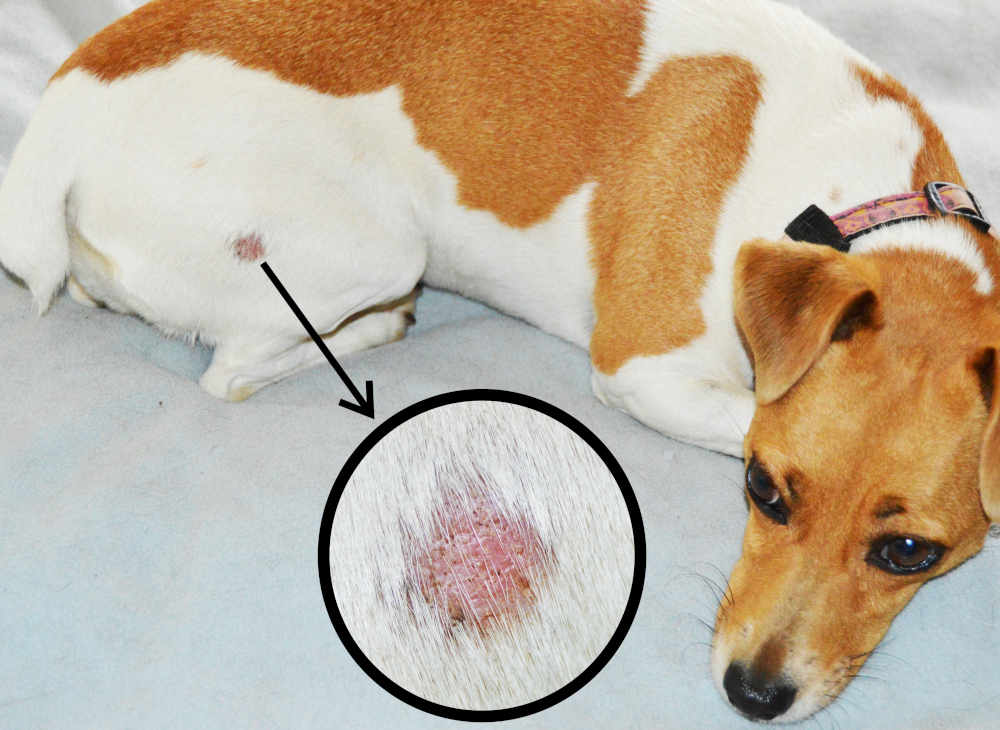
The lesions are typically circular, but they are not always in a “ring” presentation. The very outer ring is often scaly. It is an infection that can spread quickly and even pass to humans (Zoonotic).
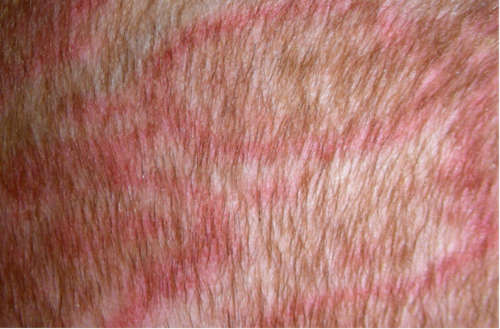
Picture: © Ian Brett Spiegel VMD, MHS, DACVD
Usually ringworm isn’t itchy, but you may notice your dog licking the hairless area. You could also see redness and inflammation of the skin that can cause itching and secondary infections. It often starts out as a spot of hair loss that may later turn red throughout the lesion or along the edges.
Here’s a look at different presentations of ringworm in dogs. Pictured below is a circular area of hair loss with a crusty, scaly center. The edges of the lesion are redder and more inflamed than the center.
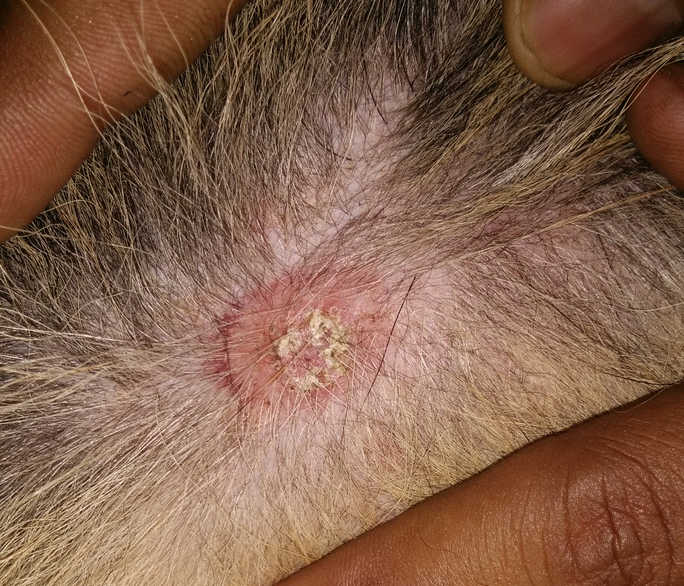
The picture below shows a ringworm lesion that is more inflamed overall, perhaps due to the dog licking it. If left untreated, the size of the spot may increase in size or become infected due to the dog licking it. As the infection progresses, the center of the area of hair loss may start to heal and even regrow hair:
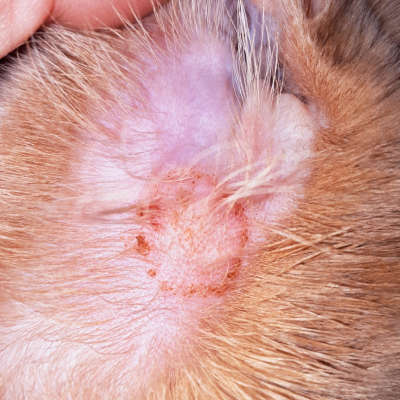
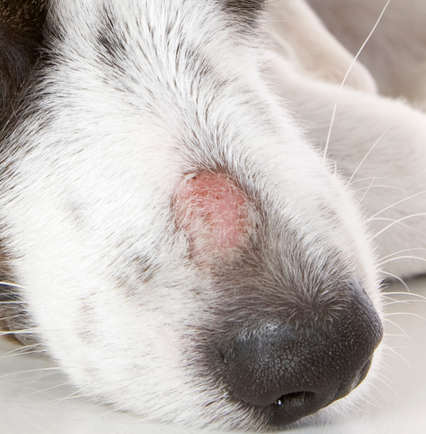
On the picture below, you can see several clearly demarcated areas where the fur is thinner, and the skin is flaky and crusty as a result of ringworm (the lesions were present mostly around the dog’s armpits, belly/groin, legs and nose.)
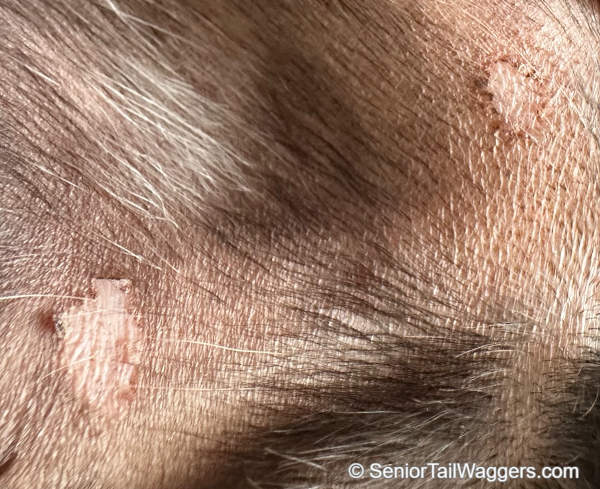
Here’s a small patch of hair loss with redness. There’s no scaliness or crusts and the dog is more than likely not itchy:
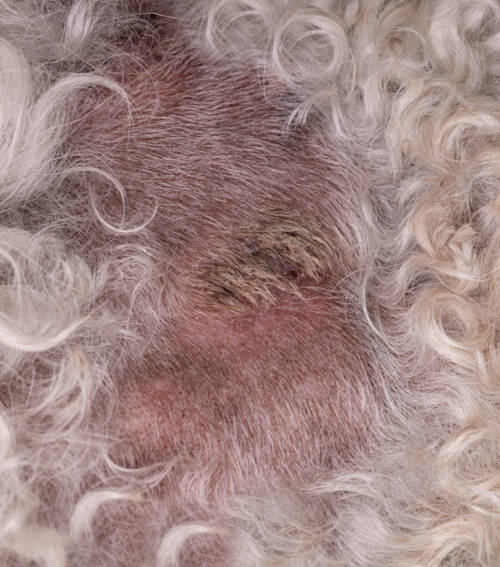
2. Pictures of lesions that look like ringworm (but are not)
On the picture below, you can see a red lesion on the head that is oval shaped and has lost fur. The skin surface is broken. This could be ringworm, but could also be a recent insect sting, a small cyst or a bacterial infection. A fur pluck or skin swab is needed to confirm diagnosis.
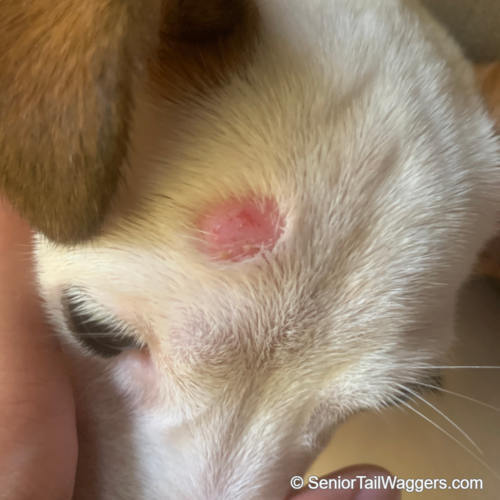
As with all common skin infections, there can be some that look similar to each other. Ringworm is no different. Skin infections, allergic reactions, and hot spots can all take on the look of ringworm, as shown on the pictures below:
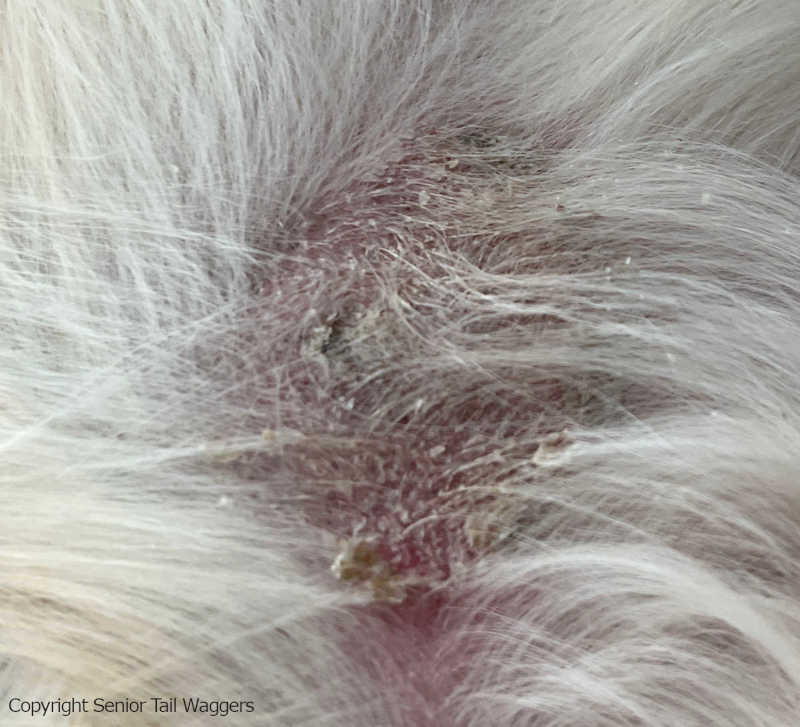
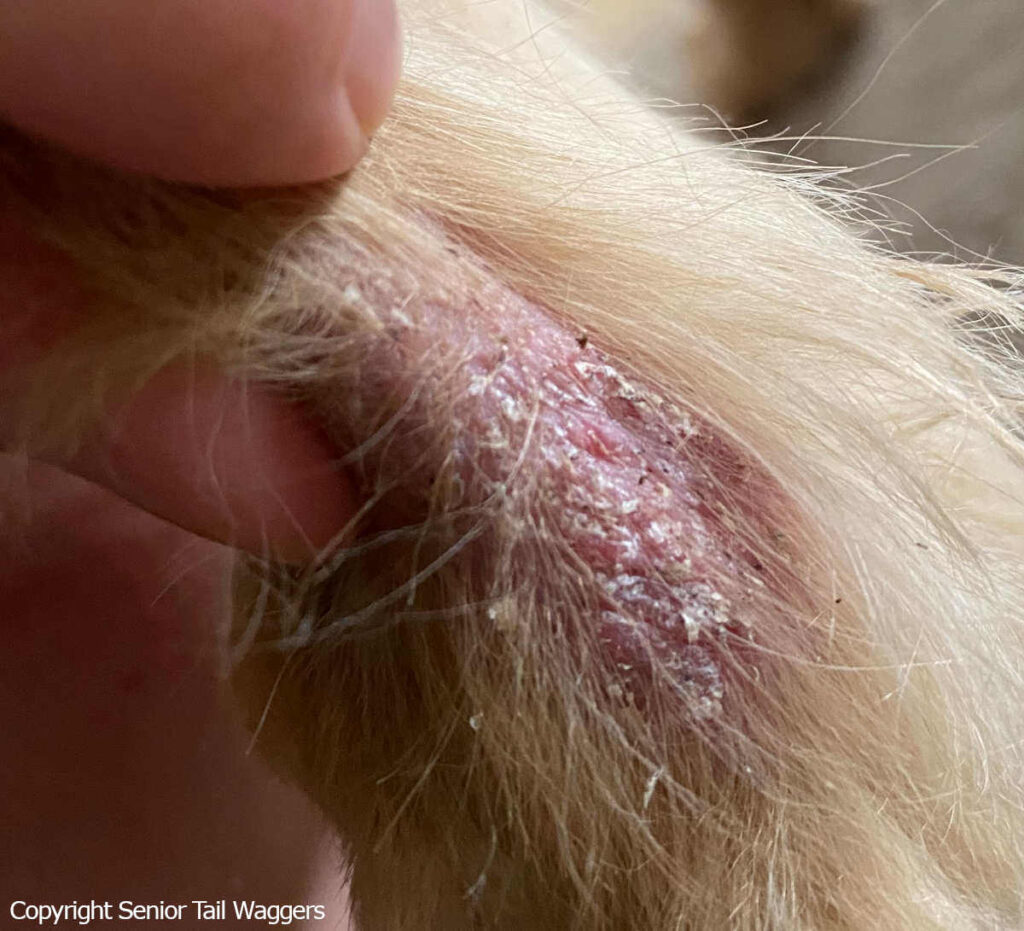
Both of these skin lesions have incomplete hair loss, meaning that the hair has thinned but isn’t totally gone in the lesion. They are also very flaky and crusty, which could mean that they are moist and oozing instead of dry and scaly.
Hot spots can sometimes be confused with ringworm infections. The picture below shows a “hot spot” that is very inflamed. It is very moist and may start to develop a foul odor. View more pictures of hot spots.
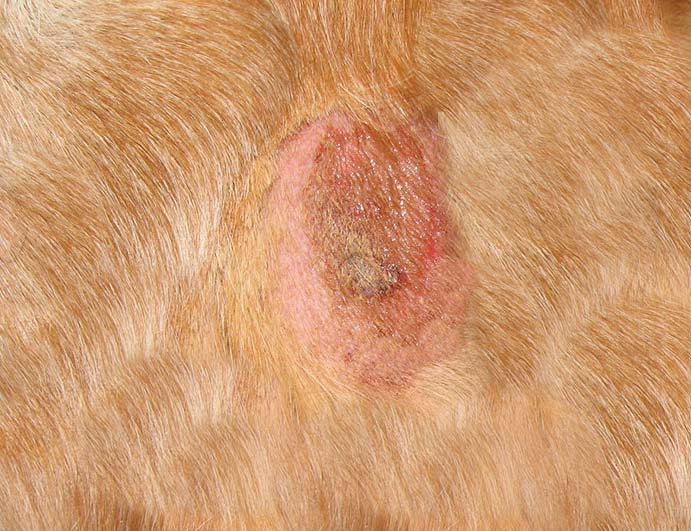
Key characteristics of ringworm lesions:
- Hair loss often in a circular pattern
- A skin lesion with red, scaly edges
- Broken or brittle hair
- Lots of dandruff
- Brittle or misshapen nails
- Red, inflamed, or dark nail beds
Ringworm can show up anywhere on a dog’s body but is more commonly found on the face, ears, tail, and feet, especially around the toenails.
3. Pictures of advanced cases: how ringworm can progress if left untreated
Depending on the severity of the initial infection, some minor cases may go away on their own. However, moderate to severe infections that don’t get treatment can become quite advanced and even unrecognizable as what we typically consider ringworm.
Warning: Images below may be considered graphic by some readers.
Although it is relatively rare, ringworm infections can spread to the entire body. As shown on the images below, you’ll see hair loss and scaly skin over large regions instead of the small, circular patches.
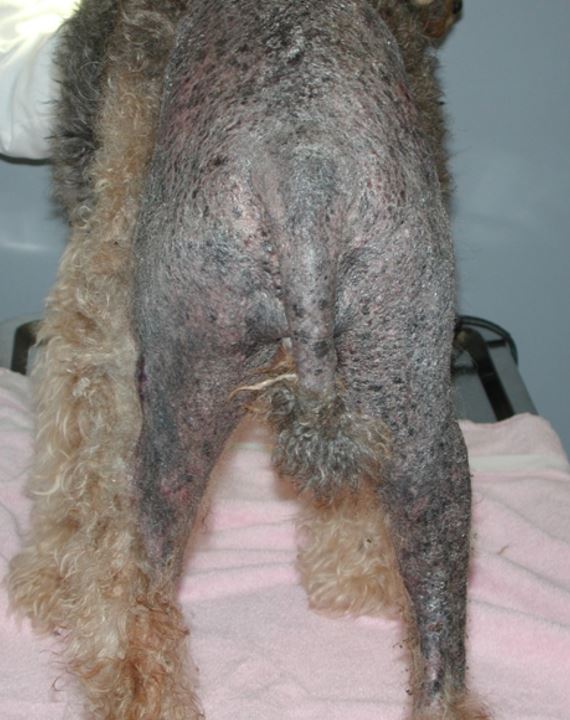
Photo: © Ian Brett Spiegel VMD, MHS, DACVD
Here are advanced cases of ringworm in which the fungal infection has spread over a large portion. There is hair loss, crusting, and scaling throughout this region. Dogs that become severely infected likely have a weakened immune system. This can include puppies and senior dogs.
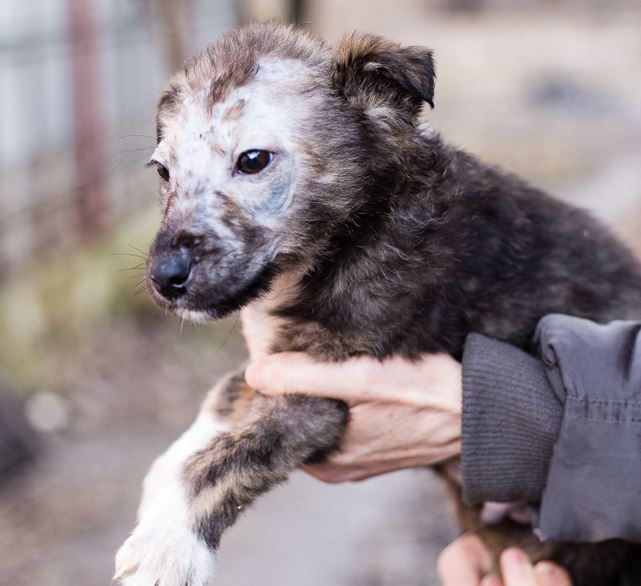
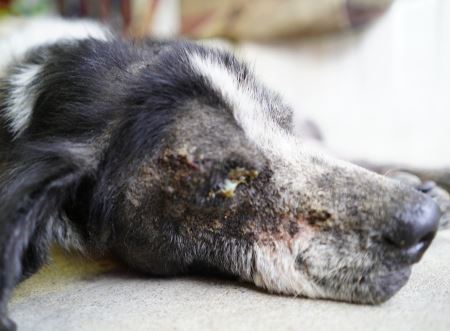
Pictured below is another severe case of ringworm on a dog’s face:
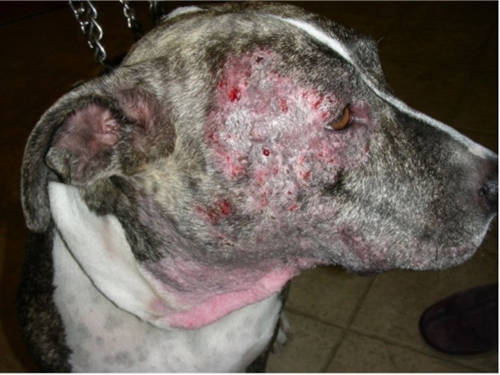
Treatment also helps to shorten the duration of the infection as well as the contagious period. So, dogs that aren’t treated will be contagious to other animals, and you, for a lot longer timeframe. They also have a greater chance of getting a repeat infection if the initial infection wasn’t treated properly the first time.
How do I know if my dog has ringworm?
One of the most common ways that dog owners diagnose ringworm is when it spreads from their dog to them or their other pets. But for a definitive diagnosis, you’ll need to get your veterinarian involved. There are a few different ways that your vet will determine if your dog has ringworm or some other skin condition.
1. Wood’s Lamp
The Wood’s Lamp is a great first-step option to try when a vet suspects ringworm. This is a special ultraviolet light that is shined on the dog’s lesions. Nearly 3/4 of infections will fluoresce green under this special light.
If a hairless patch doesn’t glow green, that doesn’t mean that it’s not ringworm. There are still the other 1/4 of ringworm infections to account for that won’t glow. The type of ringworm and the length of time a dog has had the lesion can all account for why ringworm won’t glow.
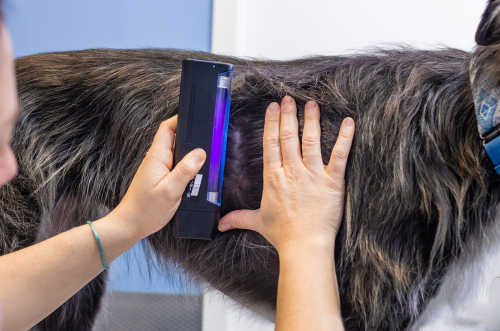
2. Culture
If a lesion doesn’t glow under the Wood’s Lamp, the next step may be to do a fungal culture. The vet will collect skin scrapings from the scales and edges of the lesion as well as some hair and attempt to grow the fungus on a culture medium. This test can take as little as 3 days or as long as 21 days for a result.
3. PCR
On the newer side of ringworm diagnosis is PCR testing. This test is run using hair collected near the lesion. It looks for the presence of fungal DNA and will have results in 3-5 days. This test can produce some false positives, so a culture may be run at the same time if there is any question.
Veterinarian’s Tip: Ringworm is contagious to both humans and other animals! Make sure to keep your pet isolated and always wash your hands after touching them, until your vet says they are no longer contagious.
Treatment
Ringworm is a fungal disease, so it should be treated with antifungals. Antifungals won’t treat allergies or bacterial infections, so it’s important that you get a proper diagnosis before trying anything at home.
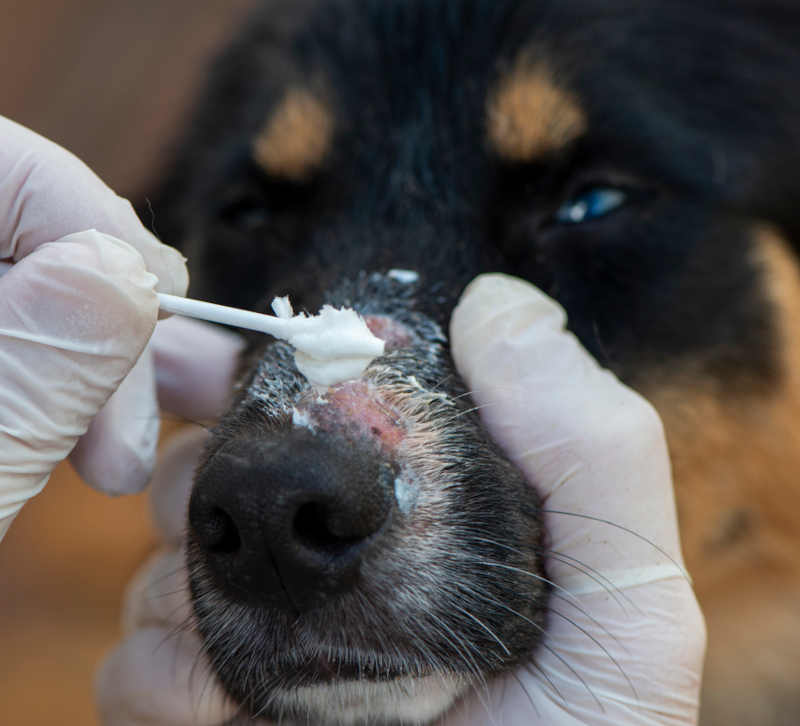
That being said, you’ll find many products labeled for curing ringworm that range from shampoos to sprays and ointments. Never use any products without veterinary supervision, as some of them may actually be harmful to your pup.
What you can do at home is try to keep your dog separate from other pets to prevent the spread and wash your hands after petting them. Try to confine them to a room or two in your house that is easy to clean.
All of the little hairs that your dog sheds every day could potentially be infected with fungal spores, so you’ll need to vacuum, sweep, or mop all surfaces to cut down on transmission. Using a dilute bleach solution can also help disinfect hard surfaces.
Veterinary Treatment
Depending on how bad your dog’s ringworm is, your vet may prescribe topical or oral antifungals, or both. Dogs with one or two lesions may get by with a medicated shampoo or ointment, while multiple lesions may require the addition of an oral medication.
Keep in mind that it takes a long time to clear an infection: potentially 4-8 weeks or longer, even with treatment. Generally speaking, the more aggressive the treatment, the less time a dog remains contagious. Your pup will need a recheck culture to make sure all of the fungal spores are gone before stopping treatment.
While treating ringworm may require a lengthy time commitment, it’s fortunately not very expensive to treat. Most dogs will cost under $100 for diagnosis and treatment. Of course, this price will increase if the infection persists and requires more medication or more in-depth diagnostics.
What should I do if my dog has ringworm?
If you notice any new lesions on your dog’s skin, it’s best to see your veterinarian. This is especially important when you suspect ringworm so that you can better prevent it from spreading to other pets or people. Keep your pup separated from others and in an easy-to-clean room.
Use any prescriptions exactly as they are prescribed at the proper dosage and length of time to keep the infection from coming back and to help cut down on the amount of time that your dog stays contagious.
How fast will my dog recover?
Ringworm is not a quick cure, no matter how aggressive the treatment is. It just takes time to kill the fungus and heal the lesion. Expect your dog to remain contagious for at least three weeks with proper treatment (more without treatment) and not to expect a cure for 4-8 weeks or more.
Disclaimer: This website's content is not a substitute for veterinary care. Always consult with your veterinarian for healthcare decisions. Read More.


Be the first to comment